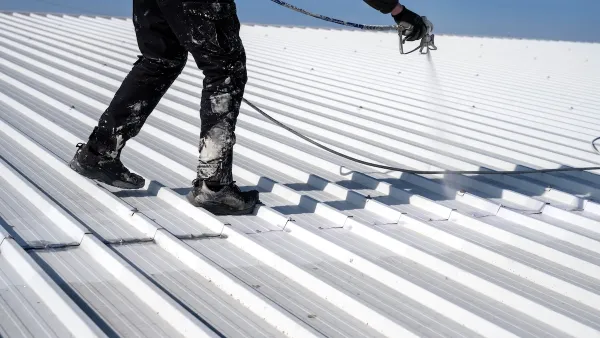Emily Badger reports on pioneering research that is looking into ways to utilize the heat trapping properties of asphalt, rather than fighting it.
The heat attracting properties of asphalt are common knowledge to anyone who's attempted to dash from the beach to their car on a hot summer day with their flip-flops in hand, and not on their feet. And, of course, the heat trapping effects of urban agglomerations of asphalt covered surfaces, known as the urban heat island effect, are well know to many planners.
As Badger notes, while a lot of work has gone into figuring out how to combat the effect, Rajib Mallick, a professor of civil and environmental engineering at the Worcester Polytechnic Institute in Massachusetts, and other researchers are working on ways to harness the heat contained in asphalt and put it to productive uses.
"Asphalt, for instance, could heat water coursing through a series of pipes embedded in the road. And that process would both cool street surfaces and send their heat somewhere useful...This heat could also be converted into different forms of energy. Other liquids that turn into vapor could be used to drive turbines generating electricity."
"Mallick and his colleagues have not only done the theoretical work to envision these possibilities, they've begun testing them as well with support from both the state of Massachusetts and the National Science Foundation," writes Badger.
What about just paving with something less heat intensive than asphalt?
"Economics drives everything," Mallick says. "And if you think about it, asphalt is very cheap. You can't find a cheaper material to build pavement. Asphalt is a byproduct of petroleum, so as long as there will be petroleum, there will be asphalt."
FULL STORY: Instead of Lamenting the Urban Heat Island Effect, Why Don’t We Harness It?

Planetizen Federal Action Tracker
A weekly monitor of how Trump’s orders and actions are impacting planners and planning in America.

Chicago’s Ghost Rails
Just beneath the surface of the modern city lie the remnants of its expansive early 20th-century streetcar system.

Amtrak Cutting Jobs, Funding to High-Speed Rail
The agency plans to cut 10 percent of its workforce and has confirmed it will not fund new high-speed rail projects.

Ohio Forces Data Centers to Prepay for Power
Utilities are calling on states to hold data center operators responsible for new energy demands to prevent leaving consumers on the hook for their bills.

MARTA CEO Steps Down Amid Citizenship Concerns
MARTA’s board announced Thursday that its chief, who is from Canada, is resigning due to questions about his immigration status.

Silicon Valley ‘Bike Superhighway’ Awarded $14M State Grant
A Caltrans grant brings the 10-mile Central Bikeway project connecting Santa Clara and East San Jose closer to fruition.
Urban Design for Planners 1: Software Tools
This six-course series explores essential urban design concepts using open source software and equips planners with the tools they need to participate fully in the urban design process.
Planning for Universal Design
Learn the tools for implementing Universal Design in planning regulations.
Caltrans
City of Fort Worth
Mpact (founded as Rail~Volution)
City of Camden Redevelopment Agency
City of Astoria
City of Portland
City of Laramie




























